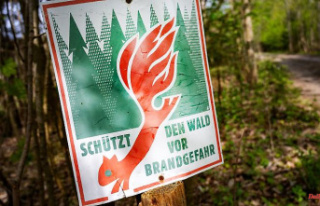There are two assumptions about where the coronavirus came from - from a laboratory or from an animal that passed it on to humans, briefly differentiated between the laboratory thesis and the zoonoses theory. Two new studies are now appearing that clearly side with each other in the dispute.
The bitter laboratory accident-or-zoonosis debate about the first appearance of the corona virus is entering another round. Two studies published on Tuesday in the scientific journal Science conclude that the corona pandemic began with at least two, but possibly more than twenty, transmission events in the Chinese city of Wuhan.
Among other things, the researchers of the first study searched through data on the earliest patients who were treated with the breathing problems, which were new at the time. According to the report, of the first 41 people hospitalized with unknown pneumonia as of Jan. 2, 2020, 27 were directly exposed to the Huanan Seafood Wholesale Market. "The initial diagnoses of Covid-19 were made independently in multiple hospitals between December 18 and December 29, 2019," write the authors, led by Michael Worobey of the University of Arizona and Kristian G. Anderson of California's The Scripps Research Institute. Overall, 55 out of 168 of the earliest known Covid-19 cases would be linked to this market.
A geographical analysis of the distribution of the first Covid cases in December 2019 shows that they were closely clustered around the Huanan Animal Market in Wuhan. Not all of the first-time patients had visited the market, some just lived in the immediate vicinity. Geographical distribution was also examined with respect to the previously known lineages A and B. Virus samples from December 2019 and January 2020 were used for this purpose. It turned out that the B-line was detected in samples taken directly from the market, while the A-line samples came from a hotel nearby and from another location in the vicinity of the market.
The scientists therefore consider it likely that both lines spread from Huanan Market to the surrounding neighborhoods during the early epidemic. "The virus began spreading among people who worked at the market, but then spread to the surrounding community as vendors went into local businesses and infected people who worked in those businesses," Worobey said in the Washington Post. quoted.
The study reconstructed the floor plan of the market from various data sets in order to further narrow down the source of the virus. By comparing commercial register data and fine notices for the illegal sale of live mammals, the researchers were able to identify five stalls "that probably sold live or freshly slaughtered mammals or other unspecified meat products in the southwest corner of the western part of the market". Among other things, foxes and raccoon dogs are mentioned.
Five positive Sars-CoV-2 samples came from one stand alone. There were also positive samples from a metal cage, two carts, such as those often used to transport mobile animal cages, and a tool for removing hair or feathers. Therefore, a connection to the animal trade is suspected. All eight Corona cases in Wuhan reported before December 20, 2019 could be traced back to the western part of the market.
In a second study, an international research team is dedicated exclusively to the two lineages A and B. Joel O. Wertheim, associate professor in the Department of Infectious Diseases and Global Public Health at the San Diego School of Medicine, and his team draw conclusions from their calculations and simulations that these lineages are the result of at least two separate human transmission events.
According to them, the first zoonotic transmission, i.e. the virus crossing from animals to humans, probably involved lineage B viruses in the period between October 23 and December 8, 2020. The separate introduction of lineage A probably occurred within weeks of this Occurrence. The researchers consider it unlikely that Sars-CoV-2 circulated widely in humans before November 2019. "As with other coronaviruses, the emergence of Sars-CoV-2 is likely due to multiple zoonotic events," the authors write.
The scientists involved in the two studies come to the conclusion that their investigations support the zoonoses thesis. Despite this, they concede that there remain many unknowns that require further investigation. As an example, they cite the question of which animals were involved in the so-called spillover. Not only the species mentioned were sold at the wildlife market, but also live dogs, rats, porcupines, badgers, rabbits, foxes, hedgehogs, marmots and a Chinese deer species.
"These are the most compelling and detailed studies of what happened in Wuhan in the earliest stages of what later became the Covid-19 pandemic," Stephen Goldstein, one of the co-authors, is quoted as saying. Goldstein is a postdoctoral researcher in the Department of Human Genetics at the University of Utah School of Medicine. "We have convincingly shown that wild animal sales at Wuhan's Huanan Market are involved in the first human cases of the disease."
The investigations have shown "that it is simply not plausible that this virus was introduced to the Wuhan market in any way other than through the trade in wild animals," said virologist Michael Worobey from the University of Arizona. He is an author of both studies and signed an open letter last year calling for the theory of a laboratory accident at the Institute of Virology in Wuhan to be further examined. The knowledge gained since then would have made him rethink, the virologist said. The virus "emerged in this market and spread from there."
Study co-author Kristian Andersen of the Scripps Research Institute said the laboratory outbreak theory has not been disproved. It will probably never even succeed. But it is important to understand "that there are possible and probable scenarios. And that possible is not the same as probable." Jonathan E. Pekar, a PhD student in bioinformatics and systems biology who co-led the project with Wertheim, suggests that a pandemic has likely been a threat for years. "It has happened before and it will continue to happen. Nature is a better laboratory than humans will ever be," says Pekar.












